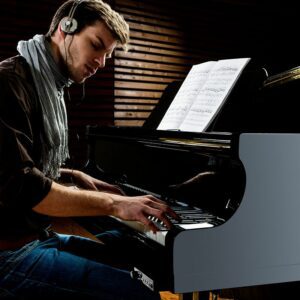What is a silent piano?
May 3, 2022 •Stephen Reed

Practicing the piano requires regular effort. However, if the player is a family member, a college student, or anyone else who shares their practicing area with other people, a natural conflict can arise between the player and others who can hear his or her playing. Even a well-played piece can be a distraction for those who need a quieter place to live, work, and sleep.
Remedies for this shared space conundrum have evolved. For example, in the 1980s, piano companies like Yamaha made their middle pedal a “soft pedal,” muffling the piano’s sound considerably. However, the resulting sound wasn’t that helpful for the serious piano student. What the “soft pedal” models gained in quietude they lost in clarity.
As a result, a solution was sought that allowed for a high-quality, acoustic piano that produced a rich sound yet only heard by the person playing. This way, the player could play anytime, night or day, as loudly as needed, without interfering with others in the same shared space.
If you have a situation where shared space with a piano player could be an issue, understanding top-quality silent piano systems is critical as you determine the best piano and silent system for you. The last thing you want is to invest in a silent system that doesn’t meet your needs.
Steinert & Sons has been in the business of helping people find the right piano for them since 1860. We have carefully followed the rise of piano enhancements like silent piano systems and can help you compare the better ones.
Naturally, we stand by the silent system we sell, PianoDisc QuietTime, but we appreciate other high-quality silent systems, as well, and are conversant regarding their capacities.
By the end of this article, you will have a better understanding of how silent systems work for the piano, how some of the better systems compare with one another, and their cost.
What is a silent piano?
A silent piano, also known as a “silent system,” may sound like a whole new kind of instrument. However, it’s simply a standard acoustic piano with the ability to stop the piano’s hammers from striking the strings.
So how do you hear the notes being played if the hammers do not strike the strings?
How a silent system works
Early silent system models detected key movement by using mechanical sensors that affected the touch and produced a clicking sound. But in more advanced, modern models, optical sensors are used that do not affect the feel or sound of the piano.
When the silent system is activated, digital sensors pick up the piano key movement. The key movement is then converted into a MIDI signal, which is then picked up by an electronic sound module. As a result, the piano player can hear their playing through headphones without distracting others.
Such modern silent systems can have full MIDI capability to send signals with the ability to link to a computer for use with notation software. The pianos also have full MIDI capability for sending signals and can be linked to a computer for use with notation software.
Brands with high-quality silent pianos or silent systems
Kawai
Kawai’s silent acoustic pianos are known as their “AnyTime Pianos” line, with a built-in silent system. They market the “AnyTime” name to denote that these pianos have a digital capacity that allows them to be played at any time without affecting others. They are available in a range of models.
One popular model is the Kawai K200-ATX3, which the company pitches as being user-friendly compared to other brands. It features a small, built-in screen on the left side of the keyboard that works similarly to a smartphone. The ATX3 features 27 voices to create the effect you wish, plus a large number of pre-set songs.
Cost of the Kawai K200-ATX3: $12,095
Yamaha
Yamaha’s SH2 and SC2 silent pianos offer a lesser number of voices and pre-set songs as Kawai’s ATX3. Instead of a built-in screen, Yamaha uses a separate interface–an iPad/iPhone or Android tablet. As with the aforementioned Kawai AnyTime models, a Yamaha silent piano has its silent system built-in.
These models have a particular standout feature: they offer binaural sound sampling for a fuller piano experience. Binaural audio mimics the natural human form to create a rich, stereo sound.
Cost of the Yamaha C2X SH2: $57,899.
Cost of the Yamaha B3SC2: $13,099.
PianoDisc QuietTime

Steinway went in another direction and does not make pianos with a built-in silent system. Instead, Steinway dealers like M. Steinert offer a silent system, the PianoDisc QuietTime is one such system, that can be installed in any piano of your choice–even one you already own.
As with the Yamaha and Kawai models, QuietTime connects the player to the digital world through USB or Bluetooth MIDI.
Beneath the keys, special optical sensors capture the motion of each key and translate this for playback by the digitized piano sound in the control box.
Once QuietTime is properly installed and adjusted by a trained piano technician, the keys will have the feel like a traditional, acoustic piano even when the mute feature is activated.
Cost of installing the QuietTime system on any pianos: $3,380.
Here at M. Steinert & Sons also experimenting with another silent system, the Kioshi Silent system - and will update in a future article about our experience with this new product.
Piano buyers benefit from testing different kinds of silent pianos, whether they are pianos with built-in systems or ones that can be installed after the piano is manufactured.
Silent systems must be sampled to be appreciated
If ever there was a piano buyer who should try some different models before purchase, it would be the buyer seeking a silent piano. After all, a silent piano has multiple constituencies to please.
On one hand, the piano player wants to make sure that they can still hear what they’re playing through the headphones. On the other hand, those in the same shared space with the piano player want to know that the silent feature is going to actually be quiet, so as not to distract their other activities.
Many buyers bring their whole family to test these key aspects of silent pianos, whether they are pianos with built-in systems or ones that can be installed after the piano is manufactured.
At M. Steinert, we encourage you to try other brands’ silent pianos and then come to us to learn more about the QuietTime system. We want you to get the best piano for you. This is best achieved after a buyer has a thorough process of comparing silent piano models and silent systems.
For more information, view these two videos that give more details as to how the QuietTime system works:
Steinert & Sons and the Quiet Time ProRecord
Steinert & Sons and the Quiet Time ProRecord (cont’d)
Featured Articles
Categories
- Beginner Pianos (23)
- Boston Pianos (15)
- Comparisons (30)
- Designer and Specialty Pianos (8)
- Essex Pianos (10)
- Events (11)
- Featured (24)
- Institutional (3)
- Joy of Piano (15)
- Learning About Pianos (69)
- News (35)
- Pricing and Cost (19)
- Resource Center (122)
- Roland Pianos (6)
- Spirio (15)
- Steinway Pianos (70)
- Student (14)
- Teacher (13)
- Used Pianos (20)
- Videos (19)

